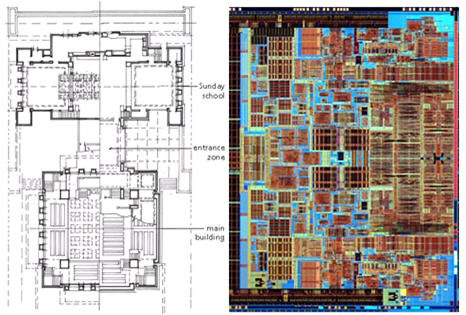Intel CEO Paul Otellini woos the Oracle crowd

Intel CEO Paul Otellini went highbrow in his keynote slot at Oracle OpenWorld, invoking American architectural icon Frank Lloyd Wright.
He was preceded yesterday by rival AMD's CEO Hector Ruiz, who chatted with partners during his keynote (see below). Both essentially gave promotional talks, which they earned through their sponsorship of the event and association with Oracle, reading from teleprompters.
Otellini started out with a quote from Wright ("Form and function should be one, joined in spiritual union."), and then showed videos of Intel "architects" talking about building chips. At nanoscale it's difficult to perceive the spiritual union in the architecture, although the wafer images at least have an artistic quality.

For Intel, the architectural union of form and function is manifest in performance, power and virtualization characteristics, which are the key drivers in rearchitecting processors, Otellini said.
He also characterized Intel as what Wright called an "architectural prophet," citing the move to a 45-nanometer process technology using hafnium metal high-k diaelectric as an example of a prophetic undertaking.
Yesterday, Intel announced a bevy of systems using the new 45-nanomenter chip. Otellini said that Intel prophetically began research on hafnium metal high-k diaelectric in 1996 and claimed that Intel has a two-year lead over competitors with the new process technology. He also touted world record benchmarks set by the new 45nm Hi-k Quad-Core Intel Xeon processor 5400 series.
Otellini didn't note that Intel unprophetically didn't see the value of point-to-point architecture between the CPU and memory as early as AMD.
Finally, Otellini addressed the big concern of the Oracle OpenWorld audience--datacenter optimization. He showed a chart (below) of the impact of Moore's Law on datacenters in terms of the profound improvements in performance, power consumption and real estate requirements even in the last few years.
(Watch a video clip of his presentation on keeping Moore's Law alive.)
He closed with the coming to era of ubiquitous computing, where the cost of MIPs approaches zero.
On the other hand, Intel expects to sell billions of processors for billions of dollars to support the need for trillions of Web searches, billions of mailboxes and trillions of IMs and videos consumed on the Internet. He relished in the fact that 60 million users play around in rich, 3D environments and that by 2010 and an estimated 70 percent of content will be created by individuals, not commercial companies such as movie studios.
Otellini concluded that the "future in this sense is not very far away. The highly collaborative, interactive global social network is nearly upon us."
It's not a prophetic vision, but Otellini wants to make sure the Oracle crowd divines that Intel should be a core part of the rearchitecting of their businesses.
Yesterday, AMD's Hector Ruiz told the OpenWorld attendees that energy efficiency and global Internet accessibility are the big challenges facing the industry. Then he brought AMD friendlies on stage, HP CTO Shane Robison, Sun EVP of systems John Fowler, and Dell marketing chief Mark Jarvis, to respond to questions posed by consumers of AMD processors, Electronic Arts, MLB.com and Lucasfilm.